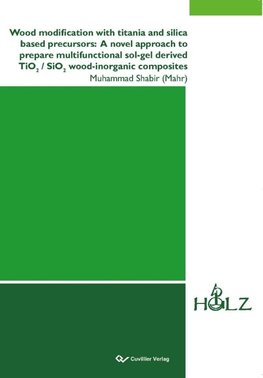
-
 Anglický jazyk
Anglický jazyk
Wood modification with titania and silica based precursors
Autor: Muhammad Shabir (Mahr)
This dissertation is devoted to explicitly investigate the suitability of titania and silica based precursors for wood modification. Novel TiO2 / SiO2 wood inorganic composites were prepared by two-step process. In first step, freshly prepared precursor... Viac o knihe
Na objednávku
26.37 €
bežná cena: 29.30 €
O knihe
This dissertation is devoted to explicitly investigate the suitability of titania and silica based precursors for wood modification. Novel TiO2 / SiO2 wood inorganic composites were prepared by two-step process. In first step, freshly prepared precursor solutions of silicon and titanium alkoxides were vacuum impregnated (one or more cycles) to oven dried pine sapwood (Pinius sylvestris L.). Precursor solutions with nano-scaled species and particulates (TiO2 and SiO2) were soaked by the entire wood matrix during this step. In (second) subsequent curing step, these penetrating liquids transformed into respective gel layers and depositions therein by sol-gel processing (in-situ hydrolysiscondensation). Sol-gel based depositions were evenly covered on the cell walls in the form of thin layers. These gel films were not crack-free however; very few cracks were visible in the gel coatings present within the wood matrix of composites prepared with precursors of low alkoxide content. In addition, the gels were randomly distributed, found to be mainly deposited in the wood cell lumen and also localized in the cell walls as ESEM-EDX mapping revealed. The impregnated samples show an increase in mass and volume expressed as eight percent gain (WPG) and bulking (B). Both of the parameters are decisive for tailoring a number of physical properties of the resultant composites. In general, moisture and water sorption capacities were decreased by 43 to 50 % while antiswelling efficiency (ASE) and bending strength (MOE) of the precursor-modified wood (composite) were increased up to 34 % and 41 % respectively, when compared to unmodified wood. These improvements are attributed mainly to gel depositions in the wood structure that physically interact with the wood matrix consequently narrowing the main flow passages there and reinforcing strengths of the fiber. These materials show superior resistance against fire of different scenarios. In small scale fire, their flame was retarded markedly (up to 78 % in optimum case) in comparison to wood controls as studied by oxygen index test (LOI). Cone calorimetric investigations revealed their better fire retardancy in terms of time resolved heat release rates (HRR) in the developing fire scenario. A remarkable reduction of 40 % in the second peak of HRR was achieved through sol-gel treatment. Furthermore, fire hazards such as CO and total smoke production were considerably lowered for these materials. Beside these improvements, reductions in first peak HRR and in fire load (total heat evolved) were not worth considering in compliance to fire retardancy principles. In relation to the mechanism of protection, it can be concluded that stable gel layer (independence of material loading) inside the wood retards markedly the proceeding combustion processes (oxidation) after first pyrolysis by improving the overall protection properties of the fire residue. These materials show excellent resistance against bio-deterioration. Almost full decay protection was achieved against wood destroying brown rot fungi (Coniophora puteana and Poria placenta) in 10 weeks laboratory trials only with 1 mass% loadings (WPG). Mass loss in prolonged test (16 weeks) was similar to 10 week lasted test indicating that protection is permanent. In addition, composites imparted moderate resistances against soft rot fungi and very minor one against surface blue stain. The lowering in moisture content that discourages fungal colonization, gel layer that provides better shielding against fungal exposure and unhydrolyzed alkoxides (organics) that probably induce biocidal effects are the main reasons for protection against biological attack in these materials. Composites are utmost leach resistant because of the insolubility of gel depositions in water as well as due to their fixture into the wood matrix.
- Vydavateľstvo: Cuvillier
- Rok vydania: 2013
- Formát: Paperback
- Rozmer: 210 x 148 mm
- Jazyk: Anglický jazyk
- ISBN: 9783954045709

 Nemecký jazyk
Nemecký jazyk 









